There is so much noise and confusion about the ‘de-monetization’ move by Namo that I thought to myself, “How can one explain this business in a very simple to understand fashion?”
This is my sincere attempt 🙂
First: Monetization
We all talk about de-monetization, but first let’s consider the concept of Monetization.
Travel with me back in time and place yourself in a small coastal town thriving with business and people but without a bank and currency.

Rodinhood is a Marwari Entrepreneur (even back then) and quickly arrives in this city smelling an opportunity!
In a town hall meeting called by Rodinhood, the big problem facing the town is that there is no ‘currency’ in place to help people trade goods, buy items for consumption and sell goods in small lots. Gold is the only valuable commodity that people use to trade things with each other.
So for example, one gold piece is given by a merchant to buy 10 sacks of wheat from another merchant. That merchant in turn spends that piece of gold to buy 10 sacks of corn. When people want half a sack or wheat or corn, there is no currency available to trade.
Exchanging gold pieces between people is becoming highly chaotic in town. There is no way to pay for small goods and services. There is a constant doubt about the purity and the exact weight of the gold pieces.
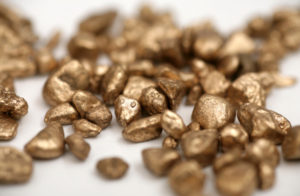
There is a crying need for an easier solution!
Rodinhood immediately comes forward and proposes “TheRodinhoods Bank”. Think of it as TRHB if you may!

The Bank’s working concept is very simple:
TRHB will ‘buy gold’ and issue TRH Bank notes in exchange. These are printed and kept safely in the TRHB vaults.
Now the question is – why would people trust TheRodinhoods Bank with their precious gold? That’s because TheRodinhoods Bank is from the community of therodinhoods – known to be the best and honest folks in the world :). So, there is no doubt about their credibility!
On the day TRHB opens for business, this is how it proposes ‘monetizing’ the gold of the town
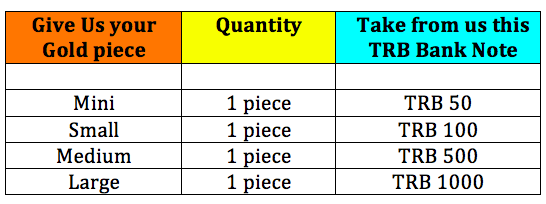
Over the next few months, the following TRHB notes get issued
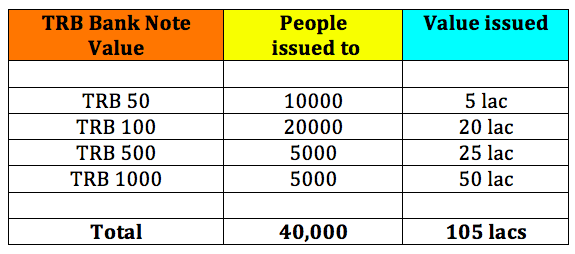
A year later, this is the status
- Because there are TRH Bank notes in circulation, traders, businessmen and householders now keep exchanging notes with each other for regular business.
- The issuance of new currency notes by TRHB slows down because the local town has been ‘monetized’ to start with. Now, only when:
- New goods beyond those in circulation are introduced that new notes are demanded from TRH Bank, which it prints and issues promptly.
- ‘Services businesses’ in the town also begin to ramp up which were earlier not easy to charge for and pay in gold – haircutting saloons, restaurants, doctors, lawyers etc. The increase in such services also requires the issuance of TRHB notes.
The Government of India is very pleased and calls Rodinhood (CEO of TRHB) to Delhi and congratulates him for an amazing job done. (Rodinhood is also given a hint that he will be rewarded a Pabma Vibhushan award).
In discussions with the Finance Minister, The TRH Bank is also allowed to
Open Branch offices in all other cities and towns in India and follow the same model it perfected in the small town.
Issue currency notes to people as loans & advances WITHOUT getting Gold in return. This is a very important point to note. Now, TRH Bank is allowed to print notes and issue ‘value’ to people without any underlying gold value. All TRH Bank has to do is to create a paper LIABILITY in its books against all the currency it issues without Gold.
If by now you have missed thinking of a very important question – let me ask it for you : “What happens to the Gold collected initially by the TRH Bank?
Answer : The government borrowed the Gold from TRH Bank on interest (payable in Gold or TRH currency) for the Govt to exchange this Gold with other governments of the world to buy goods, services, resources, etc
To summarize part 1:
- The TRH Bank takes Gold and monetizes it by issuing paper currency
- The TRH Bank’s Gold is loaned and used by the Government for Global Trading with world Governments
- The TRH Bank earns interest on its Gold and makes money from the Government.
The TRH Bank is allowed to print money without Gold Backing and lend this paper money to Companies, Traders, Businessmen and Consumers for interest, further adding to its income.
Part 2 – Expansion of Monetization
A few years down the line, TRH Bank has become the #1 Bank of the country. Lots more banks have opened up all across Indian cities, towns and villages, all of which are under the supervision of the TRH Bank. The TRHB monitors these banks, the currency they are handling, the currency in circulation and the rate of interest that is chargeable between banks and consumers.
The issuance of Currency notes after a decade looks like this:
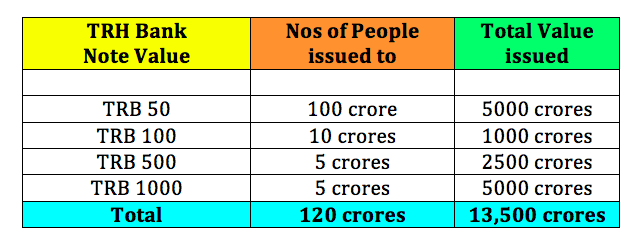
At this point of time, it is also important to know what the Balance Sheet of TRH Bank looks like?
Even if you are not familiar with Balance Sheets, it’s easy to understand. The Balance Sheet is basically a statement of Assets and Liabilities that matches up on both sides.
This is how the TRHB Balance Sheet statement looks at the end of the 10th year of its operation:
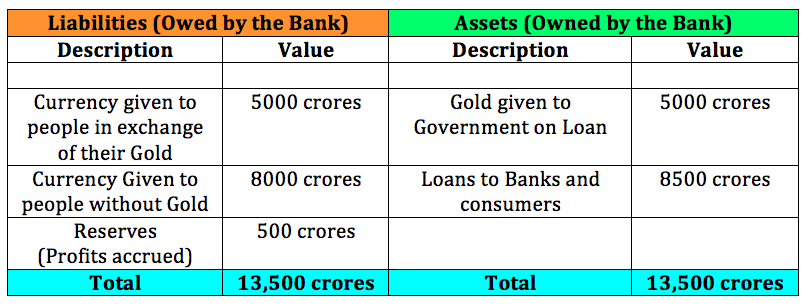
To summarize part 2:
- The TRH Bank is now the leading Bank of India and has issued 13,500 worth of currency notes
- To back this, it has 5000 crores worth of Gold, 8000 crores of credit backed by the government (for printing non gold backed currency) and also 500 crores of its own profit!
Part 3 – De-Monetization
Fast forwarding in time, the country has progressed wonderfully and the monetization of the economy has developed well. Now like every other country, there are a few unscrupulous citizens due to whom there is a ‘black’ or unofficial parallel economy that’s been built up in India. This Black Economy is preventing the Government to recover taxes and developing the country to its maximum potential.
Operation Black Ops
On a balmy winter night, the PMO calls TRH Bank CEO (Rodinhood, of course!) and explains to him the background and instructs him to effect the cancellation of the 500 and 1000 notes issued by the TRH Bank with immediate effect. The TRHB is further instructed to use new notes that is being supplied to it and allow exchange of old notes with these new notes. If there is a shortfall in the notes exchanged, TRH Bank will advise the PMO on the status.
This move takes the country by surprise and the TRH Bank begins to implement the orders of the PMO. It also calls a Board meeting to discuss what are the options ahead of it when it comes to the full effect of this ‘de-monetization’.
Rodinhood chairs the meeting and asks the board members to first look at the currency in circulation:

The Board members then discuss the issue in detail and predict that 10% of the old TRHB notes of 500 and 1000 denomination will NOT be returned by the owners fearing tax prosecution, etc.
The board takes note – 10% of these notes = 10% of 7500 crores (2500 + 5000) = 750 crores in the books of the TRH Bank.
Chairman Rodinhood then pulls up the Balance Sheet and explains his own view-
“Clearly, if this situation arises, we will have 750 crores less to pay our creditors since they will never come to the bank to recover their money.
If you examine our Balance Sheet, we have 8000 crores issued as currency not backed by gold. We will now have to pay or service only 7250 crores because the rest of the 750 crores will have been extinguished.
Now, is this a gain to us? Or is it a reduction in our debt since we are agents of the government to operate the currency in India?
My belief boys and girls, ladies and gentlemen (Rodinhood loves Indigo airlines) is that:
1. While the money has been physically removed or made redundant from the system, the business that was using this money will still be in motion. Business people who were circulating this money to trade, will need new currency to do their business with and this will lead to a demand for the gap to be filled in. So the ‘need’ for this money will not disappear.
2. By printing more money to serve this need, we will once again feed the same businessmen and traders a fresh supply of money to use and start operating their black business again.
3. I would strongly suggest leaving the gap in the system that the absence of 750 crores has created so that businessmen are forced to regularize their operations and go via the real banking systems.
4. I would not consider this a profit because while we owe people less money, the old currency that we had given out is not usable anymore. I believe in win-win and not win-lose.”
Asha Chow – A board member said, “Rodinya (That’s Rodinhood’s pet name), I still didn’t understand. When we have issued TRHB 500 and 1000 currency notes, and the same have now been declared unusable by the govt. aren’t these OUR assets that have become useless, irrespective of whether they are returned or not?”
Rodinya smiled and said, “Great question. But allow me to make you think of this deeply. When our bank issued and released these bank notes, they were via loans and advances given to legitimate businesses run by account holders of our bank. Those notes then passed on and changed multiple hands as they circulated through the system. However, in our books, the loans to the original borrowers are intact, so they have to pay us back – irrespective of where those original notes eventually traveled”.
The other board members listened intently to Rodinhood’s presentation and explanation but did not completely agree with him. They suggested posting this discussion for therodinhoods members at large to discuss and debate and present a view.
Please, therefore readers, tell us what you think and the TRHB Board will consider your suggestions seriously.
Rodinhoods! Get to work! Please add your thoughts as comments!
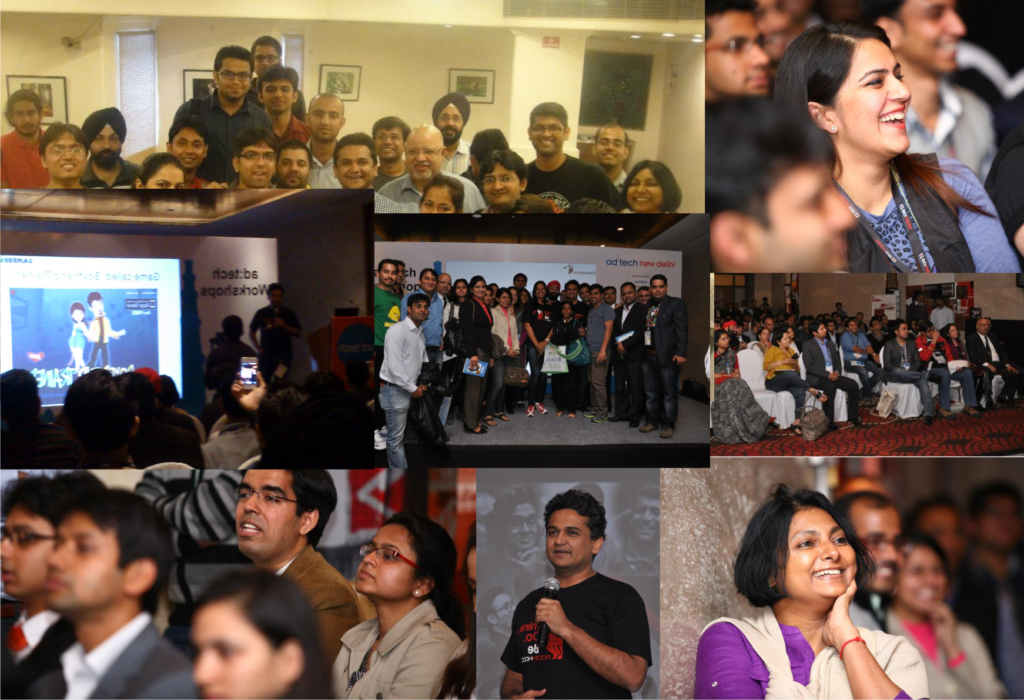
****
Afterword – I am sure you have realised by now that TRHB is my fictional allegory for the Reserve Bank of India (RBI) and that the Gold for Currency exchange is the foundation of the Central Banking System in the World !
*****





Paawan Seksaria
So first sight analysis. The 750 crores reduces as a liability of the bank. But as it was a decision of the government, the final controlling body that led to this, the GOI should be credited with this amount. The action taken was for the purpose of cleansing the system. The fruits of which are for the government to pick. And use judiciously for its citizens. The banks balance sheet remains the same.
Deepak Shenoy
If you don’t have to pay a liability it’s a one-time profit when you write it off. (Like a one time loss if you have to get money and the other side doesn’t pay you)
The profit remains. There’s no “hole” – your assets remain the same, you just have a higher profit on the liability side. You can decide not to distribute that profit as it is not earned, but that doesn’t change the nature of profit – it’s an accounting term for stuff that belongs to your shareholders.
Overall, the logic here is that money is only printed by the central bank by buying govt bonds or foreign exchange. This is done by looking at the demand in the country as banks will require money to operate (all other banks are regulated and run through the central bank). The bank above directly lends to people, and therefore has assets that have default risk – something that is dangerous. (I know Europe and US and Japan are allowing their central banks to hold risky assets, but in India it’s simply not done)
Demonetization’s impact is to make devils out of people that own large notes. THis is unnecessary, as the use is by very normal and even done by people who have no black money. The not printing of new notes will kill business which runs on cash, not because they can’t run on banks, but because banks simply don’t work for them (not enough KYC, major level merchant documentation and fees to accept cards etc). And a lot of India’s economy does. Let’s see how this pans out over the next few weeks.
Atamjeet Singh Bawa
Albert Einstein said: “Examples is not another way of teaching, it is the only way of teaching”. You are an amazing teacher sir, if a person like my could understand this complicated concept, then you have done a very good job 🙂
Pingback: Trump, do a "Namo" on the Dollar and become Immortal! - TheRodinhoods
Pingback: The Best of 2016 on therodinhoods! - TheRodinhoods
Pingback: cialis vasocostrittore
Pingback: cialis with dapoxetine without prescription mastercard
Pingback: buy generic cialis in canada
Pingback: viagra cialis trail pack
Pingback: cialis generic purchase
Pingback: buy cialis insurance
Pingback: cost of viagra without insurance
Pingback: buying cialis internet
Pingback: fastest delivery of generic cialis
Pingback: ordering cialis online australia
Pingback: buy cialis rush
Pingback: monthly cost of cialis without insurance
Pingback: how to buy cialis online from canada
Pingback: buy cialis online in canada
Pingback: sildenafil arginine
Pingback: cialis and plavix
Pingback: ordering cialis online australia
Pingback: can i buy cialis in toronto
Pingback: buy cialis tadalafil uk
Pingback: counteract viagra
Pingback: ordering cialis online australia
Pingback: how to get ciails without a doctor
Pingback: ordering cialis online australia
Pingback: phd thesis paper
Pingback: cheapest essay writing service
Pingback: nursing dissertation
Pingback: help in thesis writing
Pingback: custom essay writing online
Pingback: good customer service essay
Pingback: dissertation writing help
Pingback: can i hire someone to write my essay
Pingback: customized writing paper
Pingback: cialis online overnight shipping
Pingback: the cialis promise program
Pingback: cialis mit dapoxetine
Pingback: medical pharmacies
Pingback: mexican border pharmacies
Pingback: use cialis promise coupon orlando fl
Pingback: tadalafil 10mg price
Pingback: canada pharmaceutical online ordering
Pingback: taking cialis soft tabs
Pingback: costco pharmacy pricing
Pingback: buy cialis online generic
Pingback: legitimate canadian mail order pharmacies
Pingback: best substitute for amoxicillin
Pingback: can you get hydroxychloroquine over the counter
Pingback: cialis generika china
Pingback: generic tadalafil 5mg
Pingback: cialis free 30 day supply
Pingback: cost of tadalafil without insurance
Pingback: cialis free 30 day
Pingback: where can u buy
Pingback: homemade viagra for men recipe
Pingback: cialis retin a ortho evra patch
Pingback: mexico viagra no prescription
Pingback: hydroxychloroquine supported by doctors
Pingback: viagra france prescription
Pingback: payday loans in boise idaho
Pingback: marley generics viagra reviews
Pingback: buy now
Pingback: buy now
Pingback: online prescription for cialis
Pingback: chloroquine hydroxychloroquine covid 19
Pingback: is levitra better than cialis
Pingback: cialis and cocaine
Pingback: buy ativan australia
Pingback: ampicillin 500mg price
Pingback: northwest canada pharmacy
Pingback: 5mg cialis online canada
Pingback: osco pharmacy store locator
Pingback: cialis professionel
Pingback: buy cialis online paypal
Pingback: vietnamese careprost recipe
Pingback: canadian mail order pharmacies
Pingback: will levothyroxine cause weight loss
Pingback: hydroxychloroquine and eye damage
Pingback: keflex renal dosing
Pingback: order generic cialis online uk
Pingback: buy cialis pills online
Pingback: buy asthma inhalers without an rx
Pingback: can you buy zithromax online
Pingback: buy cheap sildenafil uk
Pingback: plaquenil hydroxychloroquine stock market
Pingback: list of sulfa antibiotics pdf
Pingback: ivermectin solution
Pingback: cytotmeds.com
Pingback: difference between acyclovir and famciclovir
Pingback: buy prednisone with mastercard
Pingback: hydroxychloroquine product insert
Pingback: cialis with dapoxetine testimonials
Pingback: order plaquenil
Pingback: side effects of priligy in men
Pingback: chloroquine pharmacy
Pingback: hydroxychloroquine patient assistance program
Pingback: doxycycline dosage for staph
Pingback: does cialis have a generic
Pingback: pharmacy tech certification online
Pingback: maximum dose of viagra
Pingback: canadian pharmacy online canada
Pingback: can i buy viagra at walgreens
Pingback: tamoxifen 10mg vs 20mg
Pingback: does viagra make you last longer in bed
Pingback: regcialist.com
Pingback: jamaica rx pharmacy
Pingback: ivermectil for dogs heart